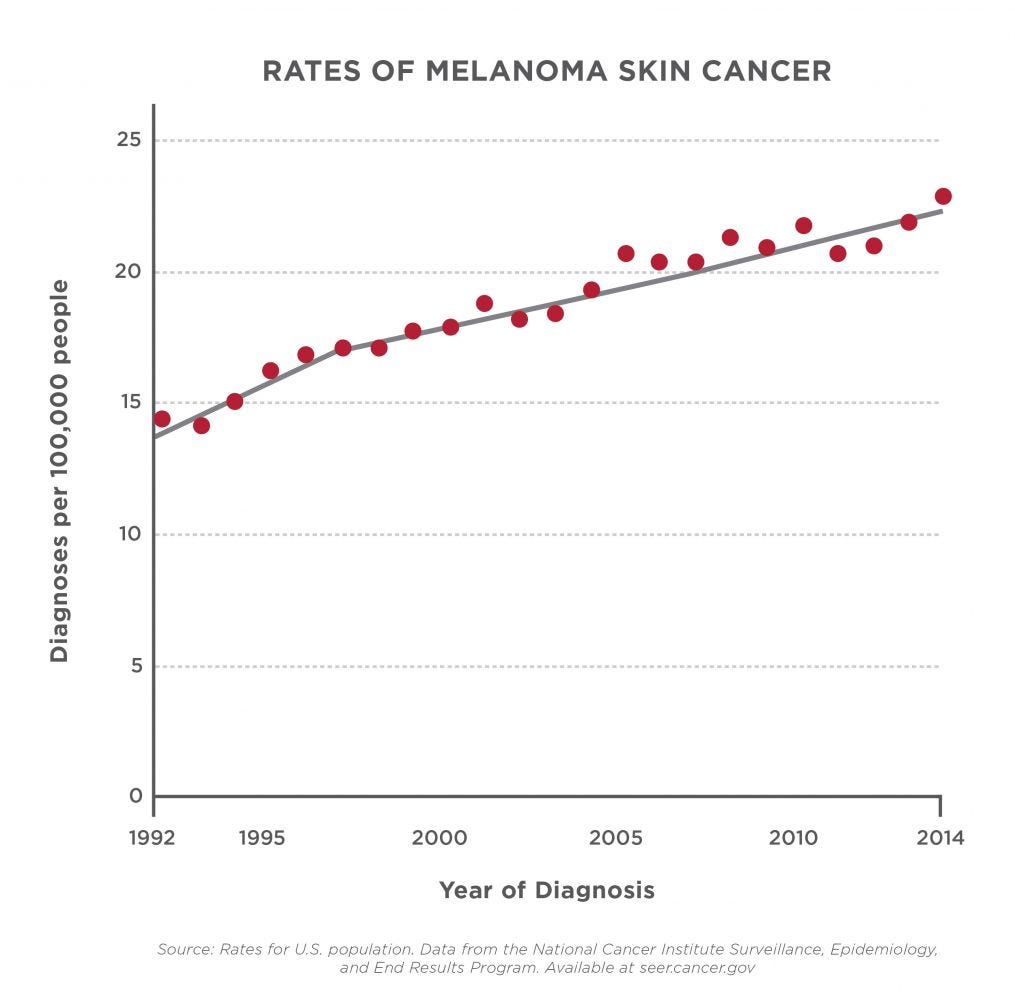Why are some people dark skinned, and some people light skinned? The most common answer is that northern climates have less sunlight, which means less vitamin D. People in northern climates evolved to have white skin, so they could get more vitamin D. In southern climates, there was more sun, and black skin evolved to resist skin damage and skin cancer.
As we will find, black skin did not evolve to resist skin cancer, because skin cancer was not an issue for pre-modern populations (especially those with brown skin, such as the populations of Indonesia, Polynesia, and South America). Skin cancer is a functional of modern mutational load, industrial pollution, and cancer-inducing sunscreens. Black skin is not indigenous to most of Africa, and has only become commonplace since 2000 BC.
The “latitude model” of skin color would expect the lightest skin people to live in northern Canada and northern Europe. However, while it is true that northern Europeans today have the lightest skin, this was not true 12,000 years ago. Like Inuit and Eskimo peoples, ancient Europeans were hunter gatherers. Specifically, ancient Europeans ate quite a lot of fish. Besides fish, their diet obtained vitamin D from eggs and liver, as well as wild mushrooms. This allowed ancient Europeans to get enough vitamin D, despite the fact that there was less sunlight.
White skin was an adaptation to agriculture. Agriculture created deadly nutritional deficiencies among the slave populations that were forced to eat carbohydrates and vegetables. How many of these people died?
During the Atlantic slave trade, 10% of slaves did not survive the journey. If 10% of the population died every generation due to malnutrition, this would provide an extremely strong evolutionary pressure for the development of white skin. Accordingly, white skin first developed in the Middle East and China, not Europe. It was only later introduced to Europe after the introduction of agriculture.
Why is Europe today lighter skinned than the Middle East or China? There are several possibilities:
Back migration. It is possible that the Middle East and China were subject to mass immigration from darker regions.
Greater selection pressure. White skin first arose in China and Kurdish-Anatolia, and then spread to Europe. Once it arrived in Europe, there was even greater selection pressure for the trait, resulting in an increased refinement of the trait.
Aesthetic preference. It is possible that European populations had an aesthetic sexual preference for white skin, especially among elites and aristocracies.
Reproductive fitness signaling. White skin shows imperfections very clearly: wrinkles, warts, acne, blemishes, scars, burns, and injuries. The development of white skin is a group-selective trait that allowed for greater discrimination in mate selection against genetic mutations.
Why is the evolution of white skin so controversial?
It proves that human evolution is dictated by human behavior (agriculture) rather than environmental determinism (climate).
It proves that human evolution, and the development of distinctive “racial” characteristics, has occurred relatively quickly, in the last 12,000 years.
The first point implies that artificial selection is not an invention of “scientific racism,” but has been practiced for 12,000 years.
The second point is insulting to two camps:
Egalitarians insist that human evolution has not occurred in the last 80,000 years; that all humans have remained genetically identical for the last 80,000 years. If humans have evolved significantly in the last 12,000 years, this makes the idea of “slow evolution over time” untenable. If humans could evolve new skin colors in the span of 1,000 years, what else could change?
Racialists insist that the White Race™ has existed for 40,000 years, completely pure and unchanged, without any variation or evolution. If races can evolve in ancient Anatolia within small time frames, what is possible with current technologies? This threatens the concept of race as an “eternal” archetype, a feature of the soul, rather than an ephemeral structure.
Skin color before agriculture.
In 30,000 BC, skin color around the world was a bit lighter than the average modern Indian and a bit darker than the average Arabian, probably lying within the current band of Indonesian skin tones.
At this time, there were land bridges between Europe and Britain, and from the Asian mainland to Indonesia.
After 10k BC, things started to change. White skin appeared for the first time in southern Anatolia, Armenia, and in China.
It is possible that the white skin of the Sino-Tibetan expansion began in the Himalayas and later spread to the Chinese coast. Depending on the earliest site of agriculture in China, it is possible that white skin developed independently on the Chinese coast.
In 2000 BC, the Bantu expansion began the genocide of the indigenous people of sub-Equatorial Africa, including the pygmy and Khoisan people. Both pygmy and Khoisan were not originally black skinned people, but brown skinned people, like Indonesians. The result is that most of sub-Saharan Africa is now black skinned, although this was not the case in ancient Africa, prior to the arrival of Bantu agriculture.
In Asia and Africa, whiteness is extremely valued, to the point that non-whites spend $8 billion dollars every year to whiten their skin.1 At the same time, mass immigration from third world countries into North America and Europe will likely result in increasing rarity of naturally white skin.
The genes for skin color and melanin production are possible to understand. If an MRNA vaccine can stimulate the production of spike proteins, why can’t an MRNA vaccine be produced to increase or decrease melanin production? It seems conceivable that in our lifetime people will be able to take a shot to genetically change their skin color, or through gene editing, select certain skin colors for their children. While the world may be getting browner in 2024, the end of this century might be far whiter than any of us expect.
2024: Analyzing Global Interest in Skin Whitening by Geographic Region. https://www.ncbi.nlm.nih.gov/pmc/articles/PMC11018027/




![No spoilers] Am I the only person who interpreted the water tribe people's appearance as a black/white mix rather than as Inuit? : r/TheLastAirbender No spoilers] Am I the only person who interpreted the water tribe people's appearance as a black/white mix rather than as Inuit? : r/TheLastAirbender](https://substackcdn.com/image/fetch/$s_!NRl7!,w_1456,c_limit,f_auto,q_auto:good,fl_progressive:steep/https%3A%2F%2Fsubstack-post-media.s3.amazonaws.com%2Fpublic%2Fimages%2Fe9d765aa-500e-4061-8a6e-12f96a779aa3_468x351.jpeg)











Masterful button pushing
10/10 dismount